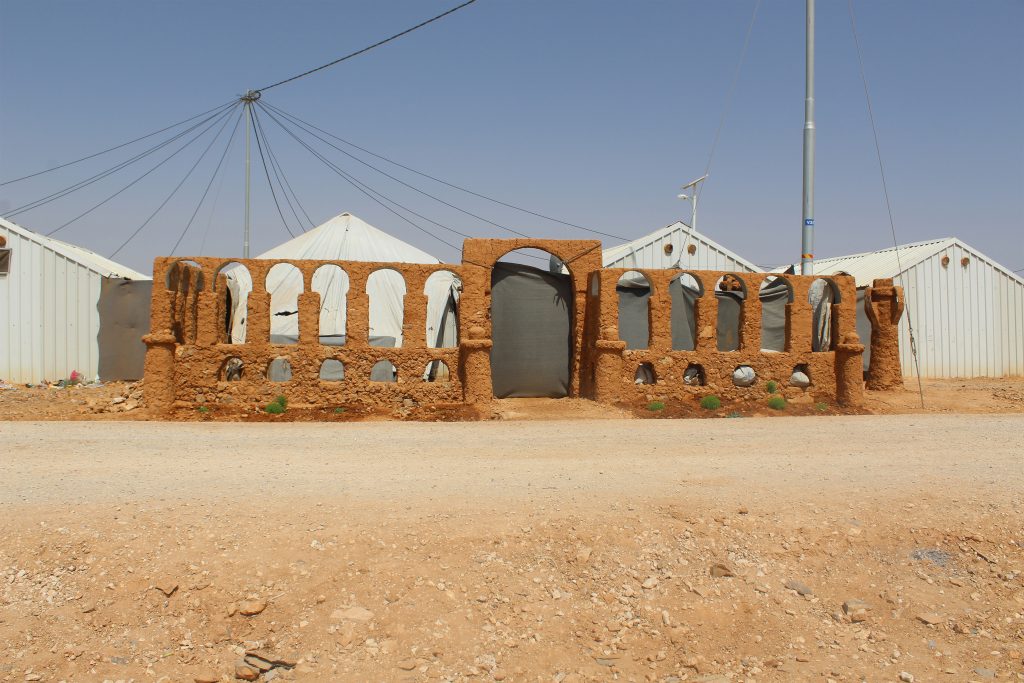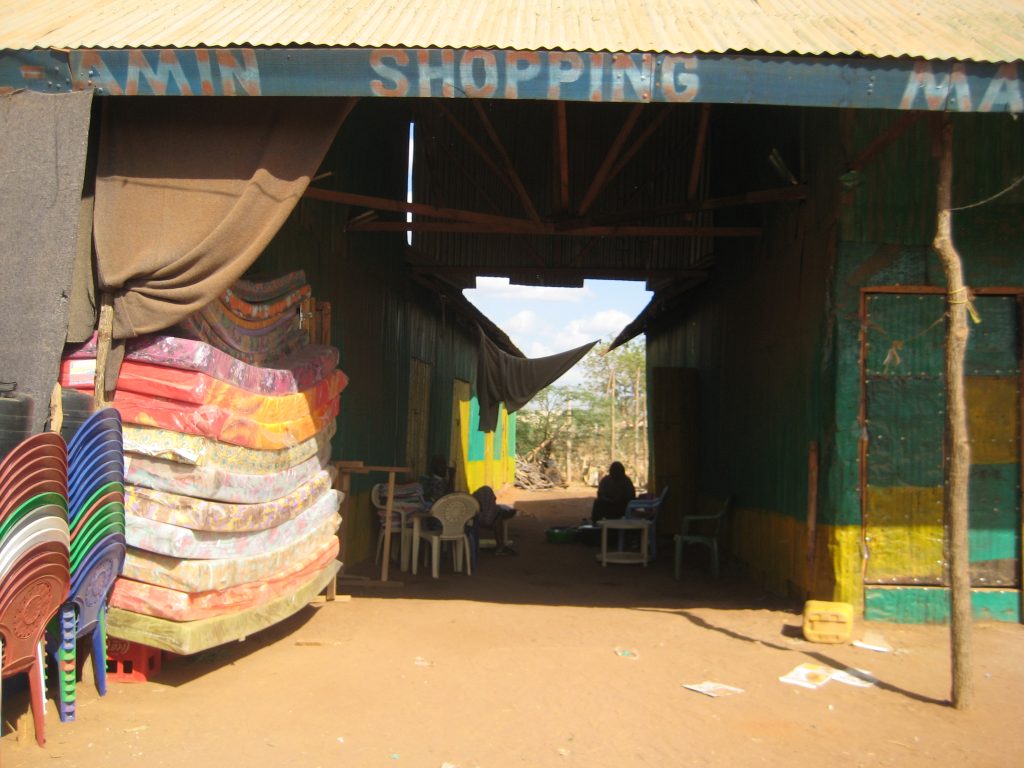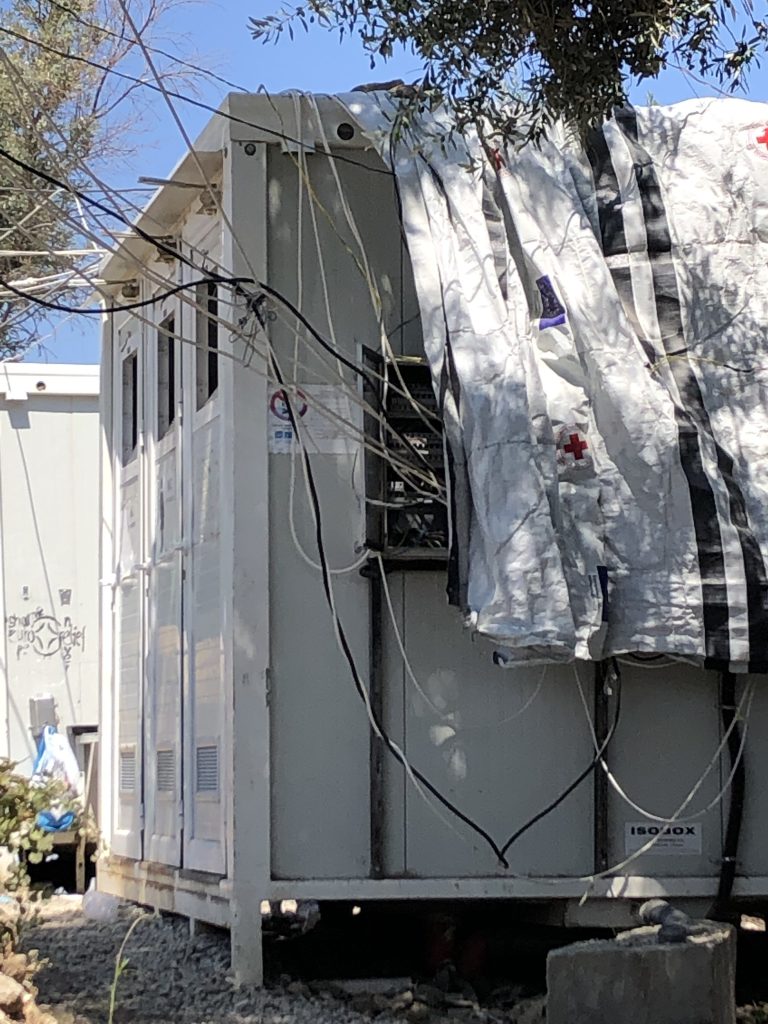Scroll down for English
Välkommen till det femte seminariet i serien Vulnerability by Design – om etiska och politiska aspekter av socialt engagerad design, gränser, kroppar och miljöer. Medverkande: Annooradha Iyer Siddiqi, Polly Pallister-Wilkins, Azra Akšamija och Mahmoud Keshavarz.
I detta seminarium kommer våra gäster att diskutera hur olika former av mänskliga förflyttningar, orsakade av samtida gränspolitik, genererar olika sociala, ekonomiska och politiska sårbarheter. Design och designande anses ofta vara en viktig del i humanitära åtgärder som svarar mot denna typ av fördrivning. Samtidigt kan dessa åtgärder ignorera, dölja eller till och med generera andra former av sårbarheter. Vilken typ av människa tänker man sig i dessa designmässiga och materiella svar? Hur reproducerar eller oroar dessa svar den gränspolitik som formar och formas av förflyttningar?

Sandslott i formen av Palmyrabågen, byggd i flyktingAzraq, Jordanien. Photo: Future Heritage Lab, 2017
Vulnerability by Design utforskar förhållandet mellan design och olika former av sårbarhet eller utsatthet kopplade till människa, djur och miljö. Design som socialt engagerad praktik engagerar sig i olika sammanhang men riskerar att även bidra till nya former av utsatthet. Vilka metoder och kunskaper behövs för att identifiera etiska och politiska aspekter av detta engagemang kopplat till olika förutsättningar och situationer? I en serie seminarium med olika fokus; gränser (Borders), kroppar (Bodies) och miljö (Environments), belysas och diskuteras detta med inbjudna svenska och internationella gäster.
Under det senaste decenniet har det skett en spridning av designmetoder som engagerar sig i frågor om sårbarhet och utsatthet kopplad till olika individer, grupper och varelser, från människor till djur och miljöer. Dessa metoder syftar ofta till att övervinna eller motverka utsatthet i dessa olika sammanhang. Här förlitar man sig ofta på designens centrala förmåga att spekulera, föreställa sig eller förutse möjliga relationer, arrangemang och konfigurationer mellan befintliga situationer och möjliga framtider. I dessa processer finns det dock många antaganden och oklarheter kring vad en utsatt situation är och om den kräver ett ingripande genom design. Vem och under vilka förhållanden kan hävda en mindre utsatt position där man kan närma sig en mera utsatt sådan och som man tycker är i behov av en designlösning? Är design bara ett verktyg, separerat från detta utsatta sammanhang som det ämnar ta sig an? Finns det en risk att designen skapar nya former av utsatthet genom att engagera sig i dessa sammanhang? Hur kan materialitet, partiskhet och begränsningar inom designen dessutom bidra till ytterligare utsatthet?
Vulnerability by Design är en serie publika evenemang på IASPIS med fokus på att kritiskt belysa och diskutera hur socialt engagerad praktik inom design och arkitektur kan engagera sig i brännande samhällsfrågor. Vulnerability by Design utvecklas av IASPIS, Konstnärsnämndens internationella program för bild och form, med Magnus Ericson, programansvarig form, i samarbete med Mahmoud Keshavarz, lektor i Design Studies på Göteborgs universitet och forskare vid Engaging Vulnerability på Institutionen för kulturantropologi och etnologi, Uppsala universitet.
Läs mer om seminariet och de medverkande nedan (på engelska).
English
Vulnerability by Design: Borders, humanitarian vulnerabilities
Date: Monday 14 November 2022
Time: 4.30 – 7.00 PM (CET)
Place: Online
Language: English
Join the seminar online
Welcome to the fifth public seminar in the Vulnerability by Design series on the ethics and politics of design engagement across borders, bodies and environments, with Annooradha Iyer Siddiqi, Polly Pallister-Wilkins, Azra Akšamija and Mahmoud Keshavarz.
In this seminar, our guests will discuss how different forms of human displacements caused by current border politics generate various social, economic, and political vulnerabilities. Design and designing are often considered an important part of humanitarian responses to displacements. At the same time, these responses may ignore, hide, or even generate other forms of vulnerabilities. What type of human is imagined in these designerly and material responses? How do these responses reproduce or unsettle the border politics that shape and are shaped by displacements?

Amin shopping mall, ”Bosnia” market, the central market in Ifo camp, Dadaab, Kenya. Photo: Anooradha Iyer Siddiqi, 2011.
Vulnerability by Design explores the intersections of what forms of human, animal and environmental vulnerabilities are engaged, resisted and/or produced by design and designing, and how the vulnerability, partiality and limits of design and designing are exposed through various tactics and techniques. It poses an urgent question: what methodologies and knowledge are required to recognize the ethics and politics of design engagement with our and others’ vulnerable conditions? Through three main themes of borders, bodies and environments, these questions and concerns will be highlighted and discussed in a series of seminars with Swedish and international guests.
In the recent decade there has been a proliferation of design practices that engage with the vulnerability of different individuals, groups and beings from humans to animals and environments. These design practices often aim to overcome or resist the vulnerable conditions in which they intervene. In doing so, they often rely on one of the main capacities of designing, in speculating, imagining or envisioning possible relations, arrangements and configurations between existing situations and possible futures.
In these processes, however, there are many assumptions and ambiguities around what constitutes a status as vulnerable which calls for a designerly intervention. Who claims the less vulnerable position from which others can be approached as more vulnerable and in need of a better design? And under what conditions? Is design merely a tool separated from the conditions of vulnerability, which it seeks to address? Is there a risk that through engaging with such conditions, the act of designing would generate other vulnerabilities often not recognized by the designers? Furthermore, how does materiality, partiality and limits of designing make design also vulnerable in its own way?
Vulnerability by Design is part of a public events programme at IASPIS, critically looking at how socially engaged practices within design, craft and architecture may engage with urgent societal issues. The programme has unfolded through various themes and formats from the Autumn 2019. Vulnerability by Design is developed by IASPIS through Magnus Ericson, Head of Applied Arts at IASPIS with Mahmoud Keshavarz, Associate Professor in Design Studies, University of Gothenburg and Researcher at the Engaging Vulnerability Programme, the Department of Cultural Anthropology and Ethnology, Uppsala University.
Azra Akšamija is an artist and architectural historian. She is an Associate Professor in the MIT Department of Architecture, Program in Art, Culture and Technology, where she directs the Art, Culture, and Technology program and the Future Heritage Lab. Her artistic practice and academic research explore how social life is affected by cultural bias and by the deterioration and destruction of cultural infrastructures within the context of conflict, migration, and forced displacement. Akšamija has been the editor of numerous publications and authored Mosque Manifesto: Propositions for Spaces of Coexistence (2015) and Museum Solidarity Lobby (2019).
Polly Pallister-Wilkins is a political geographer and associate professor in the Department of Politics at the University of Amsterdam. Her research has focused on the humanitarian responses to border violence and mobility injustice, what she calls humanitarian borderwork, and is the author of Humanitarian Borders: Unequal Mobility and Saving Lives (2022) along with numerous journal articles. More recently her work has focused on what Black feminist and Indigenous scholarship can offer for a decolonized and antiracist humanitarianism in an increasingly precarious future.
Anooradha Iyer Siddiqi is an Assistant Professor of Architecture, affiliated faculty, Barnard Art History and Columbia University ICLS, IAS, SAI, and GSAPP. She specialises in histories of architecture, modernity, and migration, centring African and South Asian questions of historicity and archives, heritage politics, and feminist and colonial practices. Her scholarship aims to foreground histories of marginalised people and figures and promote practices of collaboration and support, especially concerning the lives and narratives of communities that have been systematically excluded or silenced. Her forthcoming book Architecture of Migration: The Dadaab Refugee Camps and Humanitarian Settlement analyses the history, visual rhetoric, and spatial politics of the Dadaab refugee camps in North-eastern Kenya, as an epistemological vantage point in the African and Islamic worlds.

Moria hotspot on Lesvos. Photo: Polly Pallister-Wilkins
